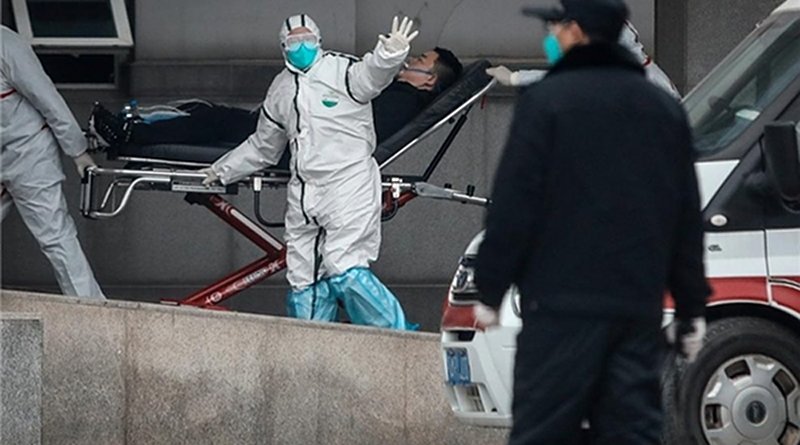How Coronavirus Outbreak Threatens National Security – Analysis
The new 2019-nCoV coronavirus infecting thousands of people in China is a human-to-human transmission pathogen that has gone global. The rapid nature of its origin in Wuhan and speed of transmission is evidence of how disease can spread from a central focal point to major points of debarkation on all continents within 36 hours. The 2019-nCoV pathogen has undergone at least four generations of spread to date, so the pathogen is able to spread much wider. Global health security during the spread of this specific coronavirus is a national security issue.
Heat maps illustrate the spread of the 2019-nCoV pathogen. The models predict a dire start to February, with further outbreaks in other Chinese cities, more infections exported abroad, and an explosion of cases in Wuhan. It is predicted that the number of infected people in Wuhan will be greater than 190,000.
The majority of the confirmed 2019-nCoV cases so far have been in mainland China. However, dozens of cases have appeared elsewhere and health authorities have established disease monitoring portals around the world as the international response begins. Given that symptoms do not show during incubation, many cases are likely to slip through the screening system.
To be sure, infectious or contagious diseases are indiscriminate, wildly uncontrollable and are able to independently evolve to counter efforts to suppress their effect. In recent years, we have seen scores of outbreaks of diseases such as H1N1 (swine flu), H7N9 (avian flu), bovine spongiform encephalopathy (BSE), also known as mad cow disease, and Middle East respiratory syndrome-related coronavirus (MERS), one of six new forms of virus from the family of severe acute respiratory syndrome (SARS). But 2019-nCoV is more aggressive. Models estimate that the number of people one victim can infect — known as the virus’ reproduction number — is between 3.6 and 4.0. SARS, by comparison, was between two and five, and measles, the most contagious disease known to humans, a whopping 12 to 18. Any reproduction number above one is a major policy problem.
Infectious disease outbreaks and their threats to human security and safety are not new. In 1918, the Spanish flu pandemic infected about 500 million people globally (a third of the world’s population at the time) and caused the deaths of 20 to 50 million victims. The 2014-2015 Ebola outbreak in Liberia, Guinea and Sierra Leone infected 28,000 and killed more than 11,000.
An outbreak of disease such as 2019-nCoV, or even the perceived threat of an outbreak, can have significant repercussions on trade and travel for the affected nation. The economic effects of infectious diseases can be devastating. The economic loss of closed ports, combined with the Chinese New Year, will be in the hundreds of billions of dollars for Beijing. For comparison, by the end of the West African Ebola outbreak, the three nations suffered a combined gross domestic product hit of $2.8 billion. Moreover, Ebola and measles outbreaks in the Democratic Republic of the Congo have killed 2,236 and more than 6,000, respectively. Obviously, given current reporting, the Chinese numbers in terms of damage to society and the economy will be much higher.
The discussion of human security versus older, traditional ideas of security is useful in understanding how the global community responds to infectious disease such as 2019-nCoV. The most obvious effect of a disease that may result in the instability of a nation or region is the death toll. Diseases with high mortality rates, especially if highly prevalent, can pose a direct risk to a nation’s security by threatening to sicken and kill a significant portion of the population; while a disease that targets sectors of a population that are relied upon for production and military protection are obviously a danger. Infectious diseases cause significant social disruption through fear and anxiety (based on accurate or inaccurate information), the loss of people in key social positions due to illness or death, discrimination against groups affected by a disease (stigma), and the loss of the majority of (or entire) specific demographic groups, which can be particularly destabilizing.
The disease spread in China appears to be overwhelming the Chinese health care system and is creating horrendous conditions in hospitals. And, with rapid transmission rates, the number of people infected in Xinjiang, for example, will be quite high. However, Chinese officials are well trained to deal with biological emergencies such as 2019-nCoV because of lessons learned from the SARS outbreak. The ability for Beijing to deploy military medical teams and construction brigades to guarantee security and to build hospitals and wards quickly is impressive. But the overall impact of the disease in China will be seen later in how the populace responds, if at all, to how the government reacted to the disease outbreak and its original source.
Overall, 2019-nCoV is another test of the global disease control system, where every country will need to be ready with disease containment measures and the possible generational jump of the pathogen.

